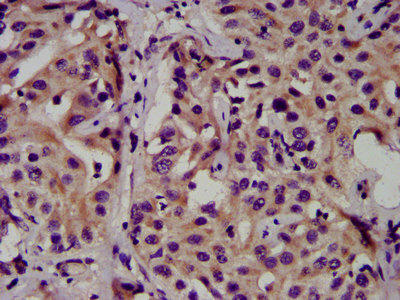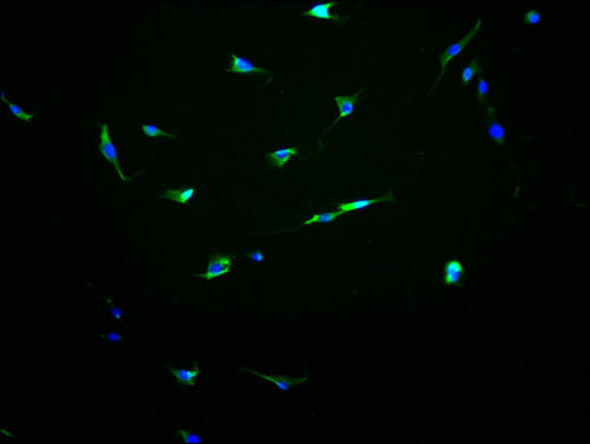Description
| Antibody Name: | CEACAM16 Antibody (PACO57696) |
| Antibody SKU: | PACO57696 |
| Size: | 50ug |
| Host Species: | Rabbit |
| Tested Applications: | ELISA, IHC |
| Recommended Dilutions: | ELISA:1:2000-1:10000, IHC:1:500-1:1000 |
| Species Reactivity: | Human |
| Immunogen: | Recombinant Human Carcinoembryonic antigen-related cell adhesion molecule 16 protein (323-414AA) |
| Form: | Liquid |
| Storage Buffer: | Preservative: 0.03% Proclin 300 Constituents: 50% Glycerol, 0.01M PBS, pH 7.4 |
| Purification Method: | >95%, Protein G purified |
| Clonality: | Polyclonal |
| Isotype: | IgG |
| Conjugate: | Non-conjugated |
 | IHC image of PACO57696 diluted at 1:500 and staining in paraffin-embedded human liver cancer performed on a Leica BondTM system. After dewaxing and hydration, antigen retrieval was mediated by high pressure in a citrate buffer (pH 6.0). Section was blocked with 10% normal goat serum 30min at RT. Then primary antibody (1% BSA) was incubated at 4°C overnight. The primary is detected by a biotinylated secondary antibody and visualized using an HRP conjugated SP system. |
| Background: | Required for proper hearing, it may play a role in maintaining the integrity of the tectorial membrane. |
| Synonyms: | Carcinoembryonic antigen-related cell adhesion molecule 16 (Carcinoembryonic antigen-like 2), CEACAM16, CEAL2 |
| UniProt Protein Function: | CEACAM16: May play a role in maintaining the integrity of the tectorial membrane. Defects in CEACAM16 are the cause of deafness autosomal dominant type 4B (DFNA4B). A form of sensorineural hearing loss. Sensorineural deafness results from damage to the neural receptors of the inner ear, the nerve pathways to the brain, or the area of the brain that receives sound information. Belongs to the immunoglobulin superfamily. CEA family.Protein type: Secreted, signal peptide; Immunoglobulin superfamily; Membrane protein, integral; SecretedChromosomal Location of Human Ortholog: 19q13.32Cellular Component: extracellular region; stereocilium bundle tipBiological Process: sensory perception of soundDisease: Deafness, Autosomal Dominant 4b |
| UniProt Protein Details: | |
| NCBI Summary: | The protein encoded by this gene is a secreted glycoprotein that in mouse interacts with tectorial membrane proteins in the inner ear. The encoded adhesion protein is found in cochlear outer hair cells and appears to be important for proper hearing over an extended frequency range. Defects in this gene likely are a cause of non-syndromic autosomal dominant hearing loss. [provided by RefSeq, May 2012] |
| UniProt Code: | Q2WEN9 |
| NCBI GenInfo Identifier: | 291190766 |
| NCBI Gene ID: | 388551 |
| NCBI Accession: | NP_001034302.2 |
| UniProt Secondary Accession: | Q2WEN9 |
| UniProt Related Accession: | Q2WEN9 |
| Molecular Weight: | |
| NCBI Full Name: | carcinoembryonic antigen-related cell adhesion molecule 16 |
| NCBI Synonym Full Names: | carcinoembryonic antigen related cell adhesion molecule 16 |
| NCBI Official Symbol: | CEACAM16 |
| NCBI Official Synonym Symbols: | CEAL2; DFNA4B; DFNB113 |
| NCBI Protein Information: | carcinoembryonic antigen-related cell adhesion molecule 16 |
| UniProt Protein Name: | |
| UniProt Synonym Protein Names: | Carcinoembryonic antigen-like 2 |
| Protein Family: | |
| UniProt Gene Name: | CEACAM16 |
| UniProt Entry Name: | CEA16_HUMAN |






